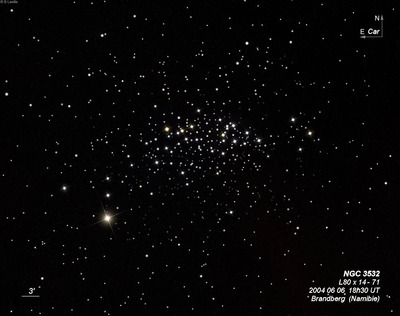Wishing Well Cluster
Wishing Well Cluster

10x30mm Canon IS (3/28/19 - Tasmania): absolutely stunning cluster - very prominent naked-eye, rivals nearby Eta Carina though smaller. A couple of dozen stars were resolved in 10x30mm binoculars including a few very bright stars. Some additional faint stars scintillated in and out of view.
Nicolas-Louis de Lacaille discovered NGC 3532 = Lac II-10 = D 323 = h3315 in 1751-1752 with a 1/2-inch telescope at 8x during his expedition to the Cape of Good Hope. He described a "prodigious number of faint stars forming a semi-circle of 20 to 25 minutes diameter."
James Dunlop observed the cluster 3 times (including first night of logging on 27 Apr 1826) and described "a very large cluster of stars about the 9th magnitude, with a red star of the 7-8th magnitude, north following the centre of the cluster. Elliptical figure: the stars are pretty regularly scattered."
John Herschel was very impressed with the cluster, including it in a list of 'greatest hits': "Among the nebulae which occur from 9h to 12h we have .. the beautiful planetary nebula [NGC 2867], a perfect planet in appearance, with an attendant satellite; the falcated nebula [NGC 3199]; Eta Argus with its nebula; the superb cluster [NGC 3532]; the blue [Herschel's italics] planetary nebula [NGC 3918], a most exquisite and unique object ; and the beautiful cluster of various coloured stars about Kappa Crucis [NGC 4755]."
His first sweep on 31 Mar 1834 reported "Chief star of a very large, round, loosely scattered cluster of stars 8..12th magnitude, which fills 2 or 3 fields. A fine bright object." His next observation recorded "The chief star of a superb cluster, which has several elegant double stars, and many orange-coloured ones." On 5 Feb 1835 (sweep 543, the night described in his diary as "most superb" and "having attained the sublime of Astronomy - a sort of ne plus ultra") he wrote,"A glorious cluster of immense magnitude, being at least 2 fields in extent every way. The stars are 8, 9, 10 and 11 mag, but chiefly 10th magnitude, of which there must be at least 200. It is the most brilliant object of the kind I have ever seen."
300/350mm - 13.1" (2/18/04 - Costa Rica): this amazing naked-eye cluster packs several hundred stars, filling the 20mm Nagler field (74x and 65' field of view) with wall-to-wall stars in a 55'x35' region! The central region is condensed and quite rich with several dense knots consisting of pairs, triples, chains, etc. The brighter stars are extended ~E-W and includes 6th magnitude K2-type star (HD 96544). There is no well-defined edge to this immense cluster although a huge "U" shaped chain of stars extends around the periphery. A neat equal-mag equilateral triangle of stars stood out within the central maze of stars.
The cluster is quite prominent naked-eye as a 45' cloud just 3° ENE of Eta Carina in the NE corner of the rich Carina starcloud and was densely packed with dozens of resolved stars in the 9x50mm finder. Mag 3.9 V382 Carinae (a Delta Cepheid variable not considered a cluster member) is just off the SE side.
400/500mm - 18" (7/7/02 - Magellan Observatory, Australia): This spectacular naked-eye and binocular cluster (3° ENE of Eta Carina) filled the entire 51' field of the 27mm Panoptic (76x) with several hundred stars mag 7 and fainter resolved. The cluster is unusually elongated ~E-W, perhaps 55'x30' and widening on the following side. The stars are irregularly distributed with many in pairs, small groups, chains and loops. A group of about a dozen stars forms a perfect "S" asterism. Interestingly, there is a lack of dense knots although the entire central region is rich. Many of the stars appear to have a blue or yellowish tint. This is one of the very top open clusters in the sky although it is probably best in a wider field view.
Notes by Steve Gottlieb